59 years ago today, Frank Herbert’s epic science-fiction novel Dune was published. Set in the distant future amidst a feudal interstellar society in which various noble houses control planetary fiefdoms, it tells the story of young Paul Atreides, whose family accepts the stewardship of the planet Arrakis. While the planet is an inhospitable and sparsely populated desert wasteland, it is the only source of melange, or “spice”, a drug that extends life and enhances mental abilities. Dune is a landmark in science fiction; a Hugo Award winner that has sold 20 million copies in dozens of languages. READ more… (1965)
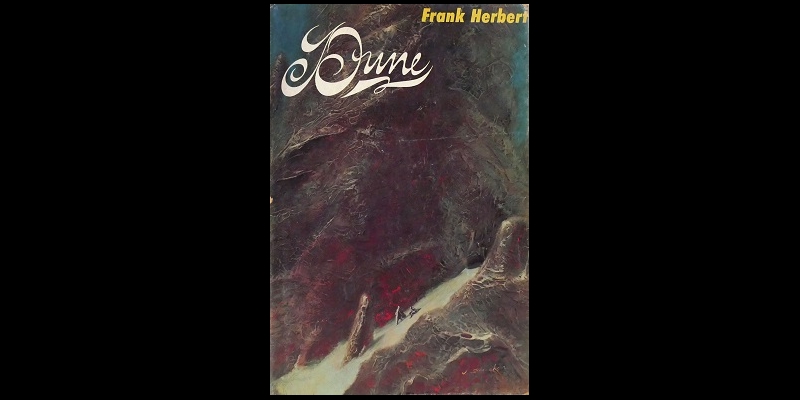
There’s a difficulty in measuring the exact impact of Dune, as it is considered perhaps the greatest science-fiction book ever written. Arthur C. Clarke the famous scientist and writer who co-wrote the screenplay for 2001: A Space Oddessey, said of Dune upon its release that “I know nothing comparable to it except The Lord of the Rings.”
Several planetary features are named after Dune, including plains on Saturn’s moon of Titan, and a crater on our Moon.
Creators of beloved science fiction content of every degree, from the tabletop miniature wargame Warhammer 40,000 to the Star Wars franchise, have often cited Dune as a seminal inspiration.
MORE Good News on this Day:
- Slavery was abolished in the British Empire (1834)
- The first scouting camp opened on Brownsea Island in Poole Harbour, England, organized by Lieutenant-General Baden-Powell testing his idea to teach activities like camping, woodcraft, chivalry, and lifesaving—considered the origin of the worldwide Scout movement (1907)
- Harriet Quimby took her pilot’s test and became the first woman to earn a U.S. pilot’s license, joining the certified flyers in the Aero Club of America (1911)
- The Fulbright Program was signed into law, named for its advocate, Sen. J. William Fulbright, who wanted to provide scholarships to increase mutual understanding between the peoples of the United States and 144 other countries– and the program produces more Nobel Prize winners than any other academic program. (1946)
- MTV began broadcasting in the U.S. airing its first video, Video Killed The Radio Star by the Buggles (1981)
83 years ago today, the first Jeep was produced, a 4-wheel-drive vehicle born of wartime necessity that over the decades became a beloved mode of transportation for outdoor recreation lovers. Indelibly linked to freedom and fun, Jeep released the first SUV eight years later.


The milestone is being marked with the launch of distinctive 80th Anniversary special-edition models, including the new 4xe models—the first Jeep vehicles with plug-in hybrid technology. Check out the ways Jeep owners help others in bad weather. (1941)
And on this day in 1971, the groundbreaking Concert For Bangladesh was held at New York’s Madison Square Garden. Organized by George Harrison to aid victims of famine and war, the concert, which may have been the first all-star charity rock show, featured Bob Dylan, Eric Clapton, Ringo Starr, Leon Russell, Billy Preston, and Ravi Shankar.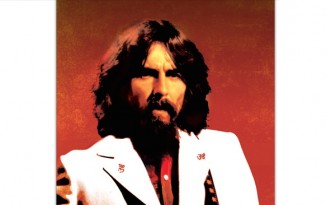
The triple album release hit No.1 in the UK and No.2 in the US and received the Grammy Award for Album of the Year. The concert raised $243,418, which was given to UNICEF and by 1985, nearly $12 million had been raised from album sales–with proceeds from DVDs and CDs today continuing to benefit the George Harrison Fund for UNICEF.
Also, on this day in 1942, Jerry Garcia, the founder of the Grateful Dead, was born in San Francisco. A son of musician parents, his distinctive guitar playing, unique for the fact that he lost his right middle finger as a child, earned Garcia the ranking of #13 in Rolling Stone’s “100 Greatest Guitarists of All Time.” Also an artist, the nature-loving counter-culture leader was plagued by drug addiction and diabetes, and died at the age of 53 of a heart attack.

Besides the wildly popular Grateful Dead music, he played on over 50 studio albums the styles of which were eclectic and varied, including bluegrass, rock, folk, blues, country, jazz, electronic music, gospel, funk, and reggae. In 2015, Jerry Garcia’s wife, Manasha Garcia and their daughter, Keelin Garcia launched The Jerry Garcia Foundation, a nonprofit charity that supports for artistic, environmental, and humanitarian causes that were so dear to him.
And, on this day in 1873, the first cable streetcar in San Francisco was tested on Clay Street Hill.
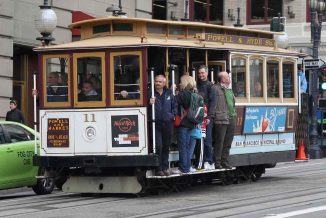
Instigated by Andrew Hallidie, the cable cars went on to become a beloved modern-day feature—and are currently the world’s last manually operated cable car system.
Legend says that Hallidie was inspired to reduce the suffering of the horses that hauled streetcars up the notably steep inclines—and when the first gripman hired to operate the car looked down Clay Street, he refused to carry on, so Hallidie took the grip himself and ran the car down the hill and up again without any problems. WATCH a video explaining the ingenious, yet simple, system…
168 years ago today, a cadre of eight climbers became the first humans to summit Monte Rosa, the second-highest mountain in the Alps.

Arising in a group of peaks on the border between Italy and Switzerland, it soars to 15,203 ft high (4,634 m). Monte Rosa’s impressive walls of granite and enormous glacial ice slopes have attracted pioneering geologists and explorers, including Leonardo da Vinci in the late fifteenth century, to study her grandeur.
Monte Rosa’s summit, then still called Höchste Spitze (“Highest Peak”), was first reached by Matthäus and Johannes Zumtaugwald, Ulrich Lauener, Christopher and James Smyth, Charles Hudson, John Birkbeck, and Edward Stephenson. Many tourists and hikers also come each year to the Gornergrat, on the northwest side, to see the panorama of giant Alpine peaks which includes the Matterhorn. WATCH a video showing climbers reaching the peaks… (1855)
And, 203 years ago today, the great American author Herman Melville was born in New York City. Though his masterpiece, Moby Dick, eventually became beloved and described as “the most ambitious book ever conceived by an American writer,” the novel was a huge flop and Melville was labeled a madman—much like the painter van Gogh, whose art was never understood or appreciated until after his death.
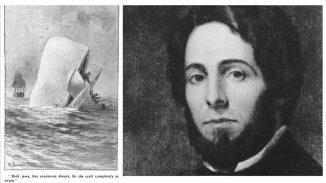
Because employment was scarce during the Great Depression, the 22-year-old Melville signed up in Massachusetts to work on a whaling ship, which planted the seeds for his first novels. After a year of adventure at sea, he and another sailor jumped ship and lived among the Polynesians for a month, an experience on which he based his first two books— Typee: A Peep at Polynesian Life, and the sequel Omoo—both of which were exciting successes.
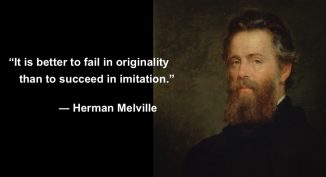
After extensive personal research into sperm whales, he wrote the dense, Shakespearean adventure-tragedy Moby-Dick, based on an actual whale that had capsized an American ship while he was a boy. Its iconic opening line, “Call me Ishmael”, is among literature’s most famous. After a string of literary failures he took a job as a Customs Inspector and turned to writing poetry. He held the post for 19 years and won the reputation of being the only honest employee there. Melville devoted years to “his autumnal masterpiece,” an 18,000-line epic poem entitled Clarel: A Poem and a Pilgrimage, inspired by his 1856 trip to the Holy Land. Some call it the longest single poem in American literature. The title character is a young American student of divinity who travels to Jerusalem to renew his faith.
Upon retirement, his gaze returned once more to the sea. The novella Billy Budd was left unfinished at his death but was published posthumously in 1924, after interest in the centennial of his birth spurred the “Melville Revival” with critics rediscovering his works, which were finally recognized as world classics.
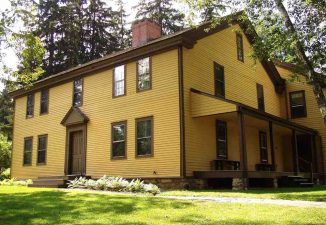
In Pittsfield, Massachusetts, you can visit the Berkshire Athenaeum, the public library that features a robust collection of the author’s personal memorabilia, manuscripts, and photos—including carved wooden canoe paddles that he collected in Polynesia, his walking stick, and favorite inkstand and quills. Visitors are also welcomed to the historically preserved farmhouse he called Arrowhead—where he lived with his growing family and wrote his most famous novels and short stories. (1819)
“Consider the subtleness of the sea; how its most dreaded creatures glide under water, unapparent for the most part, and treacherously hidden beneath the loveliest tints of azure….. Consider all this; and then turn to this green, gentle , and most docile earth; consider them both, the sea and the land; and do you not find a strange analogy to something in yourself?” – Herman Melville, Moby Dick
SHARE the Milestones, Memories, and Music…




















Great to hear good news!
Thanks for putting up these good news summaries.
In addition I’d like to add that the British government of those times, actually paid all ownbers of slaves throughout the Empire for the value of the slaves, so they weren’t out of pocket when they were forced to free them.
I’d say it was the equivalent today of say the USA banning all petrol driven internal combustion engines within its global sphere of influence, and paying people to put in Biofuel replacements, or necessary accessories.
I am so heartily sick of having only bad news day after day in conventional sources. Whne I was a teenager we lived through thre Cuba Missile crisis, and that was Bad News, until it cleared up. Then the Cold War, and all those little wars going on everywhere around the world. But today, I think the world is actually far less dangerous for many people.
Take the 2nd world War, that was the same level of violence as the Twin Towers going down every 4 hours……….for 5 years 24/7 without a break.
Things are safer, and the world better with positive outcomes being worked on energetically by many many people. There are obviously still so many problems but now we are getting collectively organised to do something about it.
So, keep on letting us know the good things,
Iain (NZ)
Thanks for writing
Iain,
I know what you mean. And I thnak you for your perspective.
I will keep posting the good news if you keep spreading the word about the site
😉
G
Dear Geri,
My pleasure to meet you today at the Panera bread store while you waiting for Shakespeare to appear in your daughter.
Regarding the Slavery issue, my “main man”, George Washington wrote “There is not a man living who more desires the abolition of slavery, but it must be done with gradual, peaceful means through legislation.”
An executice edict, or an Emancipation Proclamation, would not really work. 100 years later the Civil Rights Act – legislation – finally did what the EP could not do, reflect the will of We the People.
If every slave holder had followed GW’s example of emancipating their slaves in their will, then by a.d. 1840, or certainly by a.d. 1860, most if not all the slaves would have been freed in a gradual, peaceful means that would have allowed assimilation into the economy.
With Dr. William Allen of Michigan State back in a.d. 1999, we published an article about GW as the Man for the Millenniums, with a bit over a page of the five covering the true story of GW and Slavery, one not conveyed by most historians,
Another good story is about Quaker John Woolman. This one man made it his mission, his Christian mission, to go to all the Quaker communities from Mass. to GA, to persuade them to abandon slavery, and thereby made the Quaker denomination anti-slavery. The effect of ONE MAN with a VISION and a MIssion.
In Jefferson’s early draft of the Declaration were words blaming the King for slavery. I have those words as the opening scene of a play I wrote and performed one scene at Regent University Theater along with their Colonial Christmas premiere in a.d. 2003. My play was “A Revolutionary Christmas”. You can get a glimpse of that, and America’s first Statue of Liberty, by going deep in my http://www.WashingtonLIVES.us blog to December a.d. 2003.
Finally, I read someplace (looking for the citation) that Wilberforce was inspired to work to abolish slavery in the British Empire by Article I, Section 9 of this Constitution for the United States of America, that was the compromise
Our Constitution for the United States of America was the first National charter in the history of Man to place a limit on slavery. There is reason to consider that the Founding Fathers believed that if they could abolish the IMPORTATION of slaves, in time the INSTITUTION of slavery would dissolve. The invention of the Cotton Gin in a.d. 1792 created “King Cotton” that again made slavery profitable in cotton growing regions so slavery was continued beyond what the Founding Fathers could foresee.
For America’s future (building up on our past),
James Renwick Manship, Sr.
aka George Washington LIVES!
P.S. I have done Home School conventions in VA a few times, in Alabame and Idaho.
http://www.WashingtonLIVES.us
http://www.PrayerWarrior.US